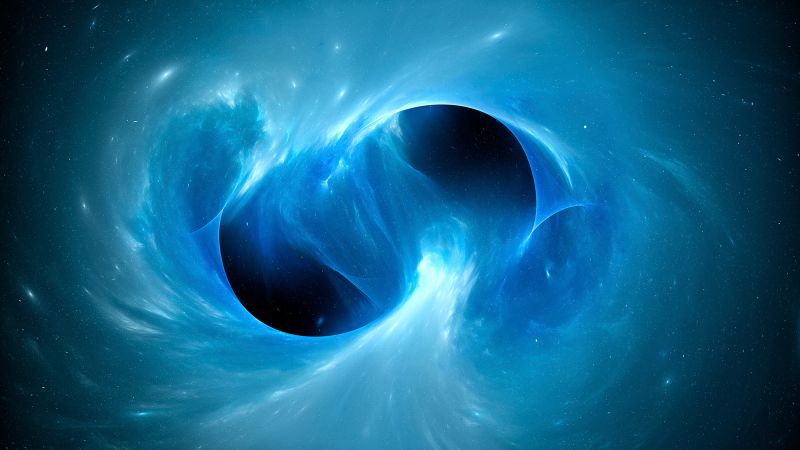A monumental event in astrophysics has emerged from the study of gravitational waves with a recent collision involving two black holes, each exceeding the mass of over a hundred suns. Dubbed GW231123, this occurrence marks the largest merger of its kind that researchers have ever documented. The event signifies a remarkable leap in our understanding of black holes and the cosmic dynamics surrounding them.
The groundbreaking discovery came to light thanks to a diligent team of astronomers utilizing the Laser Interferometer Gravitational-Wave Observatory (LIGO). This sophisticated array consists of two identical detectors stationed in Livingston, Louisiana, and Hanford, Washington. These instruments are designed to detect the subtle ripples in the fabric of space-time caused by catastrophic cosmic events, such as the collision of black holes, known as gravitational waves.
While gravitational waves were hypothesized by renowned physicist Albert Einstein in 1915 through his theory of relativity, he doubted humanity would ever possess the technological prowess to detect them due to their anticipated feebleness. However, the milestone achievement came in 2016 when LIGO made the inaugural detection of these waves during a black hole merger. This pivotal moment served to reconfirm Einstein’s predictions, earning three scientists Nobel recognition for their involvement in what’s informally acknowledged as a “black hole telescope.”
Since that initial success, LIGO—with the help of its counterpart, Virgo, located in Italy, and Japan’s KAGRA—has detected approximately 300 black hole mergers. Mark Hannam, head of the Gravity Exploration Institute at Cardiff University and a participant in the LIGO Scientific Collaboration, highlights the sensitivity of these detectors, emphasizing their extraordinary ability to observe the universe’s most violent occurrences through minuscule measurements.
However, GW231123 stands out distinctly from the other 300 black hole mergers recorded, not solely due to its mass but also due to its peculiar characteristics. Charlie Hoy, a researcher from the University of Plymouth, states that the individual black holes involved lie within a mass range that poses significant questions regarding their formation, as they do not conform to the expected outcomes from dying stars. Furthermore, these black holes are likely spinning at nearly the highest speeds theoretically conceivable, thereby challenging existing models of black hole inception.
Gravitational waves provide a unique observational lens into the cosmos, revealing insights into binary systems where two black holes orbit one another. Before the advent of these waves, astronomers were uncertain of the existence of black hole binaries, as black holes emit neither light nor electromagnetic radiation, rendering traditional telescopic methods ineffective. Einstein’s general relativity theory postulates that gravity modifies the geometry of space-time, causing rapid movements—like those of spinning black holes—to generate outward-propagating ripples.
Despite their groundbreaking revelations, gravitational waves are distinctly weak, presenting certain limitations in understanding. For instance, there’s considerable uncertainty regarding the distance of GW231123 from Earth, with estimates suggesting it could be as far as 12 billion light-years. However, Hannam expresses more confidence regarding the masses of the black holes involved, estimated to be around 100 and 140 times that of our sun.
The conundrum lies within these mass estimates, as they fall into a theoretical “mass gap”—a range between approximately 60 and 130 solar masses—where current models suggest it’s implausible for black holes to originate. The implications of GW231123 challenge conventional understandings about black hole formation and raise the possibility that these masses originate from a distinct process, potentially born from previous black hole mergers rather than from the standard stellar collapse.
Recent research proposed in a preprint published on Arxiv by Hannam and colleagues posits a compelling explanation. They suggest that the unexpected masses could stem from a cyclical process of black hole mergers, resulting in increasingly massive black holes. Such a notion opens up fascinating avenues regarding the evolution and characteristics of black holes within the universe.
The implications of these insights stress a burgeoning understanding of black holes, which are traditionally studied through their interactions with surrounding material. This new paradigm reveals a hidden population of black holes formed primarily through mergers rather than conventional stellar endings.
Researchers including Dan Wilkins from the Kavli Institute for Particle Astrophysics and Cosmology highlight the significance of gravitational waves as they uncover an intriguing new dimension to our understanding of black holes.
Further underscoring GW231123’s uniqueness is its atypically rapid rotation, diverging from the generally observed slower spins of black holes discovered through gravitational-wave astronomy. This anomaly suggests a different formation mechanism at play or necessitates a reevaluation of existing astrophysical models.
Experts predict that future advancements in gravitational wave detection, like proposed projects such as the Cosmic Explorer in the U.S. and the Einstein Telescope in Europe, could reveal even more notable black holes, deepening our cosmic inquiry. As research matures, the potential exist to unveil whether GW231123 is an isolated case or part of a more extensive phenomenon yet to be discovered.
Overall, GW231123 represents a vital












